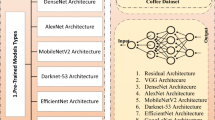Abstract
Customs classification is an essential international procedure to import cross-border goods traded by various companies and individuals. Proper classification of such goods with high efficiency in light of the rapidly increasing amount of international trade is still challenging. The current abundant e-commence data and advanced machine learning techniques provide an opportunity for cross-border e-commerce sellers to classify goods efficiently. Thus, in this paper, we propose a text-image adaptive convolutional neural network to effectively utilize website information and facilitate the customs classification process. The proposed model includes two independent submodels: one for text and the other for image. The submodels are fused by a novel method, which can adjust the value of parameters according to the model training result. Finally, we conduct a case study and comparison experiments based on a group of customs tariff codes and a data set from an e-commerce website. Experiment results indicate the effectiveness of text and image combination in performance improvement, the outperformance of the adaptive fusion method, as well as the potential of this approach when applied to customs classification.







Similar content being viewed by others
Notes
Reported by Director of China Customs, http://data.mofcom.gov.cn/article/zxtj/201802/39837.html.
References
Ding, L., Fan, Z., & Chen, D. (2015). Auto-categorization of HS code using background net approach. Procedia Computer Science,60, 1462–1471.
Li, G., Zheng, H., Ji, X., & Li, H. (2018). Game theoretical analysis of firms’ operational low-carbon strategy under various cap-and-trade mechanisms. Journal of Cleaner Production, 197(1), 124–133.
Sun, J., Li, G., & Wang, Z. (2018). Optimizing China’s energy consumption structure under energy and carbon constraints. Structural Change and Economic Dynamics, 47, 57–72.
Sun, J., Wang, Z., & Li, G. (2018). Measuring emission-reduction and energy-conservation efficiency of Chinese cities considering management and technology heterogeneity. Journal of Cleaner Production, 175, 561–571.
Macgabhann, L. (2012). The e-commerce sales and use tax controversy: Is the end near? Journal of Information Systems Management,29(4), 331–337.
Dakhlia, S., & Strauss, R. P. (2013). Should sales taxes be imposed on e-commerce? Journal of Public Economic Theory,15(6), 803–828.
Hughes, J. F., & Glaister, K. (2001). Electronic commerce and international taxation: A square pegin a round hole? European Management Journal,19(6), 651–658.
Grüschow, R. M., Kemper, J., & Brettel, M. (2016). How do different payment methods deliver cost and credit efficiency in electronic commerce? Electronic Commerce Research and Applications,18, 27–36.
Martin, A. K., & Andrade, N. N. G. D. (2013). Friending the taxman: On the use of social networking services for government aid in Europe. Telecommunications Policy,37(37), 715–724.
Yapar, B. K., Bayrakdar, S., & Yapar, M. (2015). The role of taxation problems on the development of e-commerce. Procedia-Social and Behavioral Sciences,195(2), 642–648.
Wu, Y., Lau, T., Atkin, D. J., & Lin, C. A. (2011). A comparative study of online privacy regulations in the U.S. and China. Telecommunications Policy,35(7), 603–616.
Han, W. (2018). The analysis on Chinese e-commerce tax losses based on the perspective of information asymmetry. Electronic Commerce Research. https://doi.org/10.1007/s10660-018-9318-7.
Li, G., Zheng, H., Sethi, S. P., Guan, X. (2018). Inducing Downstream Information Sharing via Manufacturer Information Acquisition and Retailer Subsidy. Decision Sciences. https://doi.org/10.1111/deci.12340.
Hsu, V. N., & Zhu, K. (2011). Tax-effective supply chain decisions under China’s export-oriented tax policies. Manufacturing & Service Operations Management,13(2), 163–179.
Raus, M., Flügge, B., & Boutellier, R. (2009). Electronic customs innovation: An improvement of governmental infrastructures. Government Information Quarterly,26(2), 246–256.
Urciuoli, L., Hintsa, J., & Ahokas, J. (2013). Drivers and barriers affecting usage of e-Customs—A global survey with customs administrations using multivariate analysis techniques. Government Information Quarterly,30(4), 473–485.
Appeals, T., & Swielande, H. S. D. (1998). Rolling back the frontiers: The customs clearance revolution. International Journal of Logistics Management,9(1), 111–118.
Hsu, C. I., Shih, H. H., & Wang, W. C. (2009). Applying RFID to reduce delay in import cargo customs clearance process. Computers & Industrial Engineering,57(2), 506–519.
Pourakbar, M., & Zuidwijk, R. A. (2018). The role of customs in securing containerized global supply chains. European Journal of Operational Research,271(1), 331–340.
Rovetta, D. (2009). Some reflections on customs classification and the harmonized system as tools for interpreting the schedules of commitments under GATT article II. Legal Issues of Economic Integration,36, 7–22.
Abdolshah, M., Teimouri, M., & Rahmani, R. (2017). Classification of X-ray images of shipping containers. Expert Systems with Applications,77, 57–65.
Lee, J., Lee, H. S., & Wang, P. (2004). An interactive visual interface for online product catalogs. Electronic Commerce Research,4(4), 335–358.
Aanen, S. S., Vandic, D., & Frasincar, F. (2015). Automated product taxonomy mapping in an e-commerce environment. Expert Systems with Applications,42(3), 1298–1313.
Lee, H., & Yoon, Y. (2018). Engineering doc2vec for automatic classification of product descriptions on O2O applications. Electronic Commerce Research,18(3), 433–456.
Bai, X., Shi, B., Zhang, C., Cai, X., & Qi, L. (2017). Text/non-text image classification in the wild with convolutional neural networks. Pattern Recognition,66, 437–446.
Han, D., Liu, Q., & Fan, W. (2018). A new image classification method using CNN transfer learning and web data augmentation. Expert Systems with Applications,95, 43–56.
Kazemian, H. B., & Ahmed, S. (2015). Comparisons of machine learning techniques for detecting malicious webpages. Expert Systems with Applications,42(3), 1166–1177.
Ramesh, G., Gupta, J., & Gamya, P. G. (2017). Identification of phishing webpages and its target domains by analyzing the feign relationship. Journal of Information Security and Applications,35, 75–84.
Kim, S., Kim, J., Nam, S., & Kim, D. (2018). WebMon: ML-and YARA-based malicious webpage detection. Computer Networks,137, 119–131.
Abbasi, A., Zhang, Z., Zimbra, D., Chen, H., & Nunamaker, J. F., Jr. (2010). Detecting fake Websites: The contribution of statistical learning theory. MIS Quarterly,3, 435–461.
Song, L., Lau, R. Y. K., Kwok, R. C. W., Mirkovski, K., & Dou, W. (2017). Who are the spoilers in social media marketing? Incremental learning of latent semantics for social spam detection. Electronic Commerce Research,17(1), 51–81.
Huang, A. (2018). A risk detection system of e-commerce: Researches based on soft information extracted by affective computing web texts. Electronic Commerce Research,18(1), 143–157.
Xiao, B., & Benbasat, I. (2011). Product-related deception in e-commerce: A theoretical perspective. MIS Quarterly,35(1), 169–196.
Zhang, X., Zhang, X., Li, X., Li, Z., & Wang, S. (2018). Classify social image by integrating multi-modal content. Multimedia Tools and Applications,77(6), 7469–7485.
Kalva, P., Enembreck, F., & Koerich, A. (2007, September). Web image classification based on the fusion of image and text classifiers. In Ninth international conference on document analysis and recognition, 2007. ICDAR 2007 (Vol. 1, pp. 561–568). IEEE.
Zhu, F., Ma, Z., Li, X., Chen, G., Chien, J. T., Xue, J. H., et al. (2018). Image-text dual neural network with decision strategy for small-sample image classification. Neurocomputing. https://doi.org/10.1016/j.neucom.2018.02.099.
Cheng, F., Wang, S. L., & Liew, A. W. C. (2018). Visual speaker authentication with random prompt texts by a dual-task CNN framework. Pattern Recognition,83, 340–352.
Wu, H., Huang, Q., Wang, D., & Gao, L. (2018). A CNN-SVM combined model for pattern recognition of knee motion using mechanomyography signals. Journal of Electromyography and Kinesiology,42, 136–142.
Swapna, G., Kp, S., & Vinayakumar, R. (2018). Automated detection of diabetes using CNN and CNN-LSTM network and heart rate signals. Procedia Computer Science,132, 1253–1262.
Xiao, B., & Benbasat, I. (2007). E-commerce product recommendation agents: Use, characteristics, and impact. MIS Quarterly,31(1), 137–209.
Robinson, R., Goh, T. T., & Zhang, R. (2012). Textual factors in online product reviews: A foundation for a more influential approach to opinion mining. Electronic Commerce Research,12(3), 301–330.
He, L., Zhang, N., & Yin, L. (2018). The evaluation for perceived quality of products based on text mining and fuzzy comprehensive evaluation. Electronic Commerce Research,18(2), 277–289.
Jing, N., Jiang, T., Du, J., & Sugumaran, V. (2018). Personalized recommendation based on customer preference mining and sentiment assessment from a Chinese e-commerce website. Electronic Commerce Research,18(1), 159–179.
Ma, Y., Chen, G., & Wei, Q. (2017). Finding users preferences from large-scale online reviews for personalized recommendation. Electronic Commerce Research,17(1), 3–29.
Tanha, J., van Someren, M., & Afsarmanesh, H. (2017). Semi-supervised self-training for decision tree classifiers. International Journal of Machine Learning and Cybernetics,8(1), 355–370.
Farid, D. M., Zhang, L., Rahman, C. M., Hossain, M. A., & Strachan, R. (2014). Hybrid decision tree and naïve Bayes classifiers for multi-class classification tasks. Expert Systems with Applications,41(4), 1937–1946.
Schu, G., & Scharcanski, J. (2017). A new method for building adaptive Bayesian trees and its application in color image segmentation. Expert Systems with Applications,98, 57–71.
Bi, W., Cai, M., Liu, M., & Li, G. (2016). A big data clustering algorithm for mitigating the risk of customer churn. IEEE Transactions on Industrial Informatics, 12(3), 1270–1281.
Fukushima, K. (1980). Neocognitron A self-organizing neural network model for a mechanism of pattern recognition unaffected by shift position. Biological Cybernetics,36, 193–202.
LeCun, Y., Boser, B., Denker, J. S., Henderson, D., Howard, R. E., Hubbard, W., et al. (1989). Backpropagation applied to handwritten zip code recognition. Neural Computation,1(4), 541–551.
Wei, Y., Xia, W., Lin, M., Huang, J., Ni, B., Dong, J., et al. (2016). Hcp: A flexible cnn framework for multi-label image classification. IEEE Transactions on Pattern Analysis and Machine Intelligence,38(9), 1901–1907.
Acknowledgements
The authors sincerely thank the editors and anonymous reviewers for their insightful comments and suggestions. This research is partially supported by the National Natural Science Foundation of China under the grant nos. 91746110, 71372019, 71521002, 71642004; the Joint Development Program of Beijing Municipal Commission of Education.
Author information
Authors and Affiliations
Corresponding author
Ethics declarations
Conflict of interest
On behalf of all authors, the corresponding author states that there is no conflict of interest.
Additional information
Publisher's Note
Springer Nature remains neutral with regard to jurisdictional claims in published maps and institutional affiliations.
Rights and permissions
About this article
Cite this article
Li, G., Li, N. Customs classification for cross-border e-commerce based on text-image adaptive convolutional neural network. Electron Commer Res 19, 779–800 (2019). https://doi.org/10.1007/s10660-019-09334-x
Published:
Issue Date:
DOI: https://doi.org/10.1007/s10660-019-09334-x




